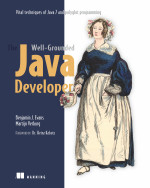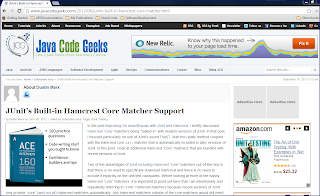I was disappointed that I was not able to attend JavaOne 2013, but was happy to see numerous useful posts covering this annual conference. In this post, I link to many of these resources and provide a brief summary of what each post discusses in relation to JavaOne 2013.
Keynotes
The keynotes are where the "big announcements" tend to occur. Fortunately, several online posts quoted key portions of the keynotes and provided different perspectives on what was said and the implications of the announcements. I group these references by order of my favorite keynotes at JavaOne: technical, strategy, and community.
JavaOne 2013 Technical Keynote
- The Java Source: The JavaOne 2013 Technical Keynote
- This Timothy Beneke post summarizes what tends to be my favorite keynote at JavaOne (Technical Keynote). Beneke quotes Brian Goetz telling the audience what I've been saying to anyone that will listen: "[Lambda expressions are] going to change the way we all program in Java every day." Mark Reinhold is also quoted, "Lambda brings 3 weapons to Java – syntax, performance and abstraction."
- The DukePad was introduced in this keynote.
- Java SE 9 and beyond were discussed, with many of the same ideas envisioned as mentioned at last year's JavaOne conference (such as modularization and generics reification).
- Application Development Trends: What's Coming in Java 8: A 'Truly Revolutionary Upgrade' Featuring Lambda
- IDR Solutions: JavaOne 2013 – Technical Keynote
- Mark Stephens's perspective on the Technical Keynote
Java 2013 Strategy Keynote
- The Java Source: At the JavaOne 2013 Strategy Keynote
- Janice J. Heiss's and Timothy Beneke's summary of the JavaOne 2013 Strategy Keynote briefly describes what was stated in relation to the "thriving state of Java," open sourcing of Project Avatar, Java as part of the Internet of Things, unifying the Java platform, and the upcoming release of Java EE 7. The post also includes an explanation of why the theme of JavaOne 2013 ("Make the Future Java") was the same as for JavaOne 2012.
- Application Development Trends: JavaOne 2013 Strategy Keynote: Unifying Java & Creating a Standard
- Another overall description of what was said including coverage of the focus on Java and The Internet of Things.
- Oracle Press Release (23 September 2013): Oracle Outlines Java Platform Advancements and Highlights Java Momentum in JavaOne 2013 Strategy Keynote
- Oracle Press Release (23 September 2013): Oracle Highlights Java SE Momentum at JavaOne San Francisco 2013
- Oracle Press Release (23 September 2013): Java ME 8 Specifications Moving Forward Within Java Community Process; Alignment with Java SE 8 for a More Unified Java Embedded Developer Platform and Ecosystem
JavaOne 2013 Community Keynote
- The Java Source: The JavaOne 2013 Java Community Keynote
- Timothy Beneke's summary of the Community Keynote demonstrates continued discussion on the theme of the Internet of Things.
- The Java Source: More on the JavaOne 2013 Strategy Keynote - IBM's Java Focus
- This Janice J. Heiss post focuses on IBM's portion of the JavaOne 2013 Strategy Keynote.
Technical Sessions
Several blog posts have been written about specific technical presentation sessions, birds of a feather sessions, and hands-on lab sessions.
- Java 8: The Good Parts
- Konrad 'ktoso' Malawski's description of the presentation Konrad and Andrzej Grzesik presented: Java8 The Good Parts @ JavaOne 2013
- JSR 341: Expression Language 3.0
- Janice J. Heiss's coverage of the Ed Burns and Kinman Chung presentation on JSR 341, Expression Language (EL) 3.0 is available in the post Session Report: JSR 341: Expression Language 3.0.
- Is It a Car? Is It a Computer? No, It’s a Raspberry Pi JavaFX Informatics System
- In the post Session Report: Is It a Car? Is It a Computer? No, It’s a Raspberry Pi JavaFX Informatics System, Timothy Beneke covers Simon Ritter's presentation in which Ritter "demonstrated how a simple Raspberry Pi computer could be connected to an Audi to access far more information about the inner workings of the Audi than is currently available."
- Demystifying Java EE
- Janice J. Heiss covers Adam Bien's presentation in Session Report: Demystifying Java EE.
- Java EE 7: Fifty New Features of Java EE 7 in 50 minutes
- Timothy Beneke covers Arun Gupta's and Antonio Goncalves's "whirlwind tour of new features in Java EE 7" in the post Session Report: 50 New Features of Java EE 7 in 50 minutes
- DataFX: The Best Way to Get Real-World Data into Your JavaFX Application
- Janice J. Heiss covers Johan Vos's and Hendrik Ebbers's presentation DataFX: The Best Way to Get Real-World Data into Your JavaFX Application.
- Making Java Groovy
- In the post Making Java Groovy at JavaOne 2013, Ken Kousen writes about his own presentation.
- Introducing the Java Time API in JDK 8
- Sharon Zakhour's post JavaOne 2013: JDK 8 Date and Time APIs mentions the Roger Riggs and Stephen Colebourne presentation on the new Java Time API in JDK 8 and ties this to the new Date-Time trail in The Java Tutorials.
- JavaOne 2013: Converting to the New Date-Time APIs is a very similar post.
- Using the New JDK 8 Security Features
- Sean Mullan posts a link to the slides of his presentation in Slides for my JavaOne session: "Using the New JDK 8 Security Features".
- JavaOne 2013 Collections Performance Fundamentals
- Mike Duigou's post JavaOne 2013 Collections Performance Fundamentals provides links to his JavaOne 2013 presentation.
- Ten Things You Should Know When Writing Good Unit Test Cases in Java
- In the blog post JavaOne 2013 – 10 things you should know when writing Good Unit Test Cases in Java, Mark Stephens states that this was his favorite presentation of that day and one of his favorite presentations overall at JavaOne 2013. One of the presenters, Stuart Marks, left some links to presentation materials in the comments section.
- The Java Tutorials' Weblog Posts
- Besides the "Introducing the Java Time API in JDK 8" post just mentioned, The Java Tutorials' Weblog features numerous other similar posts that briefly mention a particular JavaOne 2013 presentation and provide links to related documentation.
- Matt Raible's Presentations
- Matt Raible writes about his JavaOne 2013 experience and his two presentations: "Play Versus Grails Smackdown" and "The Modern Java Web Developer."
Overall Impressions and Summaries
This set of links is to posts summarizing the conference as a whole and relaying attendees' perspectives on the overall conference.
- Cay Horstmann: JavaOne for the Impatient
- Includes some different perspectives and observations on JavaOne 2013.
- Stated that attendees seemed more curious than excited about lambda expressions despite lambda expressions being, in Horstmann's words, "easily the biggest Java language change since, well, since Java 1.0."
- Horstmann highlights Bck2Brwsr and Geertjan Wielenga demonstrates how to apply bck2brwsr in NetBeans IDE 7.4 RC 1.
- IDR Solutions (Mark Stephens): My Top 10 takeaways from JavaOne 2013
- JavaOne 2013 Articles – Series Index
- IDR Solutions's JavaOne collection of posts related to JavaOne 2013
- Trisha Gee: JavaOne: The Summary
- "Controversial" perspective: "I think this was my favourite conference of this year."
- Adam Bien: JavaOne San Francisco 2013: Feedback
- Bien states, "I think it was the best JavaOne under 'Oracle's Stewardship' so far."
- Sander Mak's JavaOne 2013 trip report
- Overall summary of conference as well as discussion of presentations Sander participated in.
- Markus Eisele's Travel Report: JavaOne 2013 - Back To Glory
- Eisele states, "For me it has been the best one so far and I'm looking forward to the next year."
- JavaOne Afterglow
- "Another great event and it will be even harder to top that next year."
- Ed Burns's My JavaOne 2013: Wrapup
- Covers sessions Ed presented and those he attended.
- Richard Warburton's Javaone 2013 Review
- "If you ever get an opportunity to attend or talk at Javaone I'd highly recommend going. It doesn't have the community oriented feel of some conference I've attended, but no where else has its breadth or depth of talks."
- Peter Pilgrim's JavaOne 2013 Reports
- JavaOne 2013 Roundup: Java 8 is Revolutionary, Java is back
- Matt Raible's summary of JavaOne 2013.
- Jaromir Hamala's Posts of JavaOne 2013
Kevin Farnham's (java.net) JavaOne 2013 Impressions
Kevin Farnham, managing editor at Java.net, has been posting his impressions from JavaOne 2013 in his editorials alongside the posts he references from Java.net.
- JavaOne 2013 Impressions #1: So, Who Needs a Chess-Playing Robot, Anyway?
- JavaOne 2013 Impressions #2: What I Wish My Government Would Learn from Ecuador
- JavaOne 2013 Impressions #3: It's JavaFX versus the World (Molecules Included) in the War of the Dancing Pixels!
- JavaOne 2013 Impressions #4: How to Utilize Hadoop to Process 30 Characters in just 34 Seconds! And How to Do Much, Much More...
Conclusion
This year's JavaOne appears to have continued many of the themes discussed at last year's JavaOne including GPUs, Raspberry Pi, Java SE 8 (especially lambda expressions), Java EE 7, NetBeans, OpenJDK, and JavaFX. Of course, there were new announcements related to these themes that included DukePad, open sourcing of Project Avatar, and new OpenJDK participants (Freescale, Linaro and Square)
















